I subscribe to the philosophy that sailors should do all they readily can to prepare for bad conditions, even if the likelihood of needing the preparation is quite small. I should never have read Heavy Weather Sailing and similar books because I now visualize situations that are very unlikely for a cautious coastal sailor. In particular, the likelihood of a huge wave breaking over the stern of my 26’ Norman Cross Trimaran as I day-sail in Northumberland Strait is just about nil. Still, I want to make the step into the cabin high enough to reduce the risk of the water going below, and have the water that fills the cockpit drain out quickly enough to let the boat rise over the next breaking wave.
The particular boat has a “self bailing cockpit” which simply means the cockpit floor is somewhat above the waterline and there are holes to let out the water.
| It came to me with a grille that blocked waves from coming in when moving forward. |
 |
| If you look closely you can see the grilles off the main hull just near the rear. |
 |
There are two problems with the design, though. First, the holes are only about 1” in diameter—any larger would invite the waves to break right in. Second, when there are lots of cockpit-sitting passengers and a full gas tank, the water level approaches the floor level and, on windy days the water comes in on the floor to a disturbing degree even though with the two outer floats/hulls there is no chance of swamping.
So, while perusing the Duckworks store, I came across the Scupper Valve and wondered if I could keep the waves from sneaking in while still allowing the cockpit to drain. Will it work on the side where the current goes by at 6-8 Knots (or perhaps somewhat higher if you have the courage)? I always thought scuppers went on the transom where they were out of the current. No one seemed to know, so I figured I would try it—at under $3.50 each there was not much to lose.
| The scupper comes with 3 parts. |
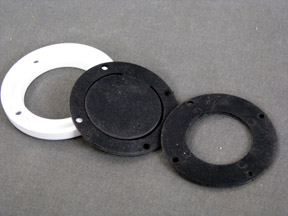 |
I think there could be two ways to mount them—with all the parts on the inside and a big hole to let the flap swing out through the hole, or with the parts on the outside and the flap swinging out through the white plastic piece.
| I chose the latter because the plastic part would protrude from the hull a bit and hopefully protect the flap from the current. |
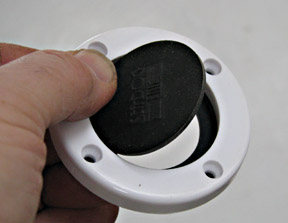 |
| It is difficult to hold the parts and the camera, but here is the sequence I used: |
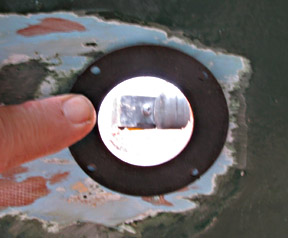 |
| Before the layers can be mounted, you need to drill a hole. Since it fit the inner opening, I used a 1 ½” hole saw. |
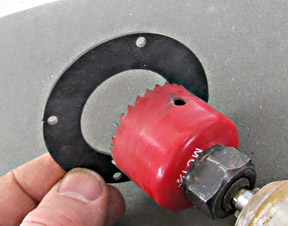 |
| If possible put the bottom of the hole a bit below the floor level to get a sort of drain. |
 |
I am a firm believer in epoxy, so I coated all cut surfaces with the stuff and used it to re-set the mounting screws as well—the last thing I want is rot getting into the plywood of my wood/epoxy hull and I’m sure the same risk applies to core material on fibreglass boats. And did I mention stainless screws? At least around saltwater anything else is a waste.
The tricky part is getting everything lined up. My suggestion is to mount the inner gasket and the white plastic part, leaving off the flapper. You can see to get the gasket lined up with the hole you drilled—just set the screws at 45 degrees (10:30 and 1:30?) so the flap will be upright. You might rotate it a bit so the flap will tend to be pushed shut by passing (from the front) current. After you have set at least two screws, back them out and insert the flap layer in-between.
| As I said, I like to reset the screws with some epoxy on the threads. |
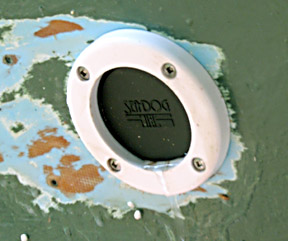 |
How well will it work? Unfortunately the ice has just gone off the harbour here (April 24) and I’m not expecting to launch until early June. Handling a flap, it seems to be made of a fairly robust material and has about ¾” of hinge, so it gives promise of holding up. Having had a full day of rain (and a bit of snow!) today, I can attest to the flaps opening enough to let the water out. It remains to be seen how they hold up sailing at top speed in high waves. I expect by September I will have a lot better idea of reliability and can give an update.
Update:
I am happy to report that the scuppers held up just fine through an entire season of sailing and there was no problem with flaps being torn off by passing current. The cockpit floor did not stay perfectly dry—sometimes a little water got in before the flaps closed, but there was never anything but a little dampness—never puddles like I got before with open drains when passing waves rose above the floor level. Of course I’ve never experienced a wave breaking in over the stern but I am confident the 1 ½” holes (x 4) would drain much faster than the old 1” restricted holes. In addition I raised the fixed board between the cockpit and the cabin by about 6”. The opening to the cabin is still lower than the deck so if the boards were out the permanent one would not keep all water out of the cabin. I had to compromise with getting in and out of the cabin having only sitting headroom.
Tom
|

